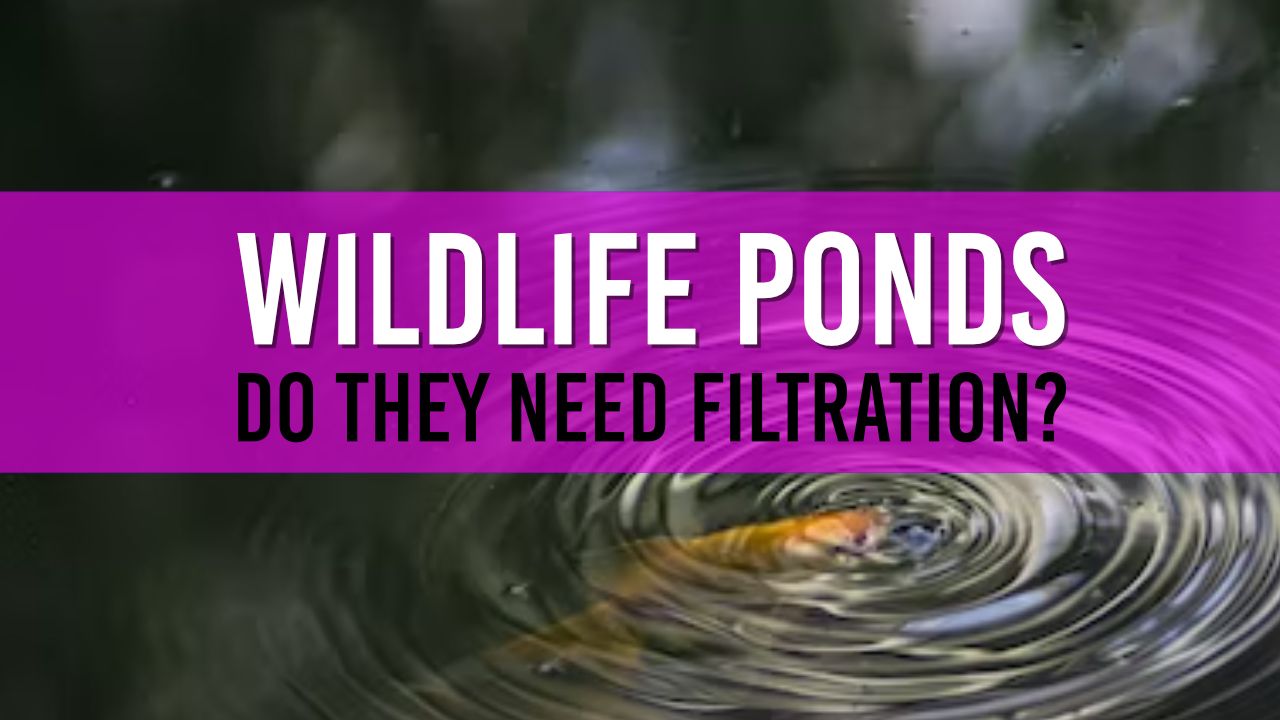Does my wildlife pond need a pump?
To ensure your Wildlife pond is a habitable place for Frogs / Tadpoles and other "wildlife" I would always recommend using a pond pump. If you do not use any form of filtration you run the risk of your wildlife pond becoming dirty, smelly and hazardous to any wildlife that uses it.

Table of Contents
We’ve seen many wildlife ponds pop up over the last couple of years and the question “does a wildlife pond need a pump” often crops up. As all pond owners know, pumps are the heart of your pond and cycle water usually to a filter box and then back into your pond.
In this article I will run through what a wildlife pond is, what happens when you don’t add a filtration, what benefits there are to adding a pump to a wildlife pond and problems you may encounter with your wildlife pond. Towards the end of the article I will provide my final conclusion on whether you actually really need to add filtration.
What is a wildlife pond?

The “wildlife pond” got it’s name from a naturally occurring area of water that has had no human additions (such as fish). This means that generally speaking a wildlife pond will be filled using natural rain water, contains no fish and maybe the odd plant or two until it becomes its own managed self supported habitat. Over time as the pond matures, life starts growing from tiny little organisms to tadpoles, frogs, newts into a thriving habitat.
Wildlife ponds should require minimal human interaction (no chemicals) with their only goal to support living creatures such as birds, insects or other small mammals. Chosen for their ease of maintenance, Wildlife Ponds can be a great new focal point of your garden, without the worries that come when managing a large stocked fish pond.
A wildlife pond is different to a “standard fish pond” as they generally do not contain any fish. They do not have any filtration, and they are very unlikely to have any form of filtration. Essentially, wildlife ponds “look after themselves” – just as nature intended.
A wildlife pond is different to a “standard fish pond” as they generally do not contain any fish. They do not have any filtration, and they are very unlikely to have any form of filtration. Essentially, wildlife ponds “look after themselves” – just as nature intended.

Wildlife ponds can be created using anything from a large trough, to a small bucket. Life doesn’t always need to visible to the naked eye. I have a few friends that have several small buckets sunk into their garden, each with it’s own eco-system, and each with different animal species – they look great!
They are a great addition to any garden due to minimal maintenance. The size doesn’t matter, the position doesn’t matter – you’re just essentially providing a water source.
What happens to your wildlife pond if you don’t add a pump?
Pumps (as mentioned above) provide water movement. As I’ve mentioned before, any body of water that does not have enough oxygen will start to suffer. Unlike Koi ponds where the water needs to be constantly cycled/filtered to remove nitrates and reduce ammonia levels – natural ponds should be self sufficient.
However, as many owners are now realising – sometimes they feel a pump might actually benefit their wildlife pond, so what happens if you don’t add one?
- Reduced Oxygen Levels – Any body of water that does not have any form of water cycling will have lower oxygen levels compared to one that has an active filtration system.
- Smelly Water – Reduced oxygen levels will cause your water to start smelling. This is very obvious in the early stages of wildlife ponds as the eco-system is not fully established.
- Reduced Wildlife – Poor water quality will not only restrict wildlife from using your pond, but it may end up negatively affecting their health – especially with blue algae breakouts.
- Dirty Water – Due to the lack of filtration, you may notice that your water has become cloudy / dirty. Dirty water will start to make the area in and around your pond smell and may attract some unwelcome visitors.
What benefits will I notice after adding a pump to my wildlife pond?
Depending on the size of your pond, adding filtration can positively affect the water quality ensuring that any life that uses / lives in your pond will benefit greatly. Pumps, whether it’s a small fountain, or a fully contained “all in 1” solution will eventually make your water much healthier.
- Increased Oxygen Levels – Flowing water will break the surface tension allowing more oxygen to penetrate deeper into the pond water which greatly benefits life in and around your pond.
- Clear Water – Adding a filter to your pond will suck up small pieces of debris and trap it in the sponges before to ensure the water remains clearer – even during Autumn when leaves start dropping.
- Safer Water – Obviously as humans, we’re not going to be drinking from the pond, however animals such as birds will greatly benefit from safer drinking water.
- Improved Plant Growth – Water that does not contain high levels of nitrates / ammonia will flourish. Plants need fairly good water to bud, flower and grow.
- More Wildlife – If you create better habitat conditions, the more wildlife will frequent your pond. A huge array of different species will start breeding in your wildlife pond fuelling it’s ecosystem.
How to fix problems with your Wildlife Pond
Wildlife ponds as mentioned earlier should require little to no maintenance – however, being pro-active with identifying issues will help prevent damage or even death to local wildlife. I have prepared a table below with some common issues you may face, and the actions that you should take to fix.
Caused by increased Nitrates/Ammonia in the water.
Remove 25%-40% of the water using a bucket and refill using natural rainwater (if you do not have any rain water – then use tap water mixed with tap safe).
Caused by decaying surface debris which has sunk to the bottom of your wildlife pond.
Remove and clean your liner with clean fresh water. Remove any leaves / branches / twigs that may have fallen into the pond – then refill using only natural water.
If you are using an all-in-one pump and filter – clean the filter using cold water and return to your pond – be sure to check the filter media after 24 hours and clean if required.
Caused by an Algae Bloom
Algae feeds off nitrates in your water. Firstly, remove as much green algae as possible and drain about 25% of the water from your pond. Re-fill using natural water (or tap-safe treated water)
Caused by Animal Waste / Dead Plants
Increased Nitrates in your water will ultimately cause nitrate poisoning. Remove any foreign items from the pond and perform a 25% water change, then after 24 hours perform another water test.
Caused by Poor Quality Water / Lack of sunlight.
First check the water using a pond water test kit for ammonia & nitrate levels. If the levels look ok you might need to find different plants suitable for the amount of sunlight the wildlife pond receives.
Caused by Leak or Increased temperature
If the water level has dropped in your wildlife pond you can often just top it up using rainwater (from a rainwater butt), or treated tap water.
However, if the water level is dropping very quickly you may have a leak in your liner/bucket/trough – which will require you to drain the entire pond to either repair or replace.
Caused by Increased Rainfall
Overflowing ponds due to heavy rainfall can cause your plants and other life to float out of the boundaries of your pond. Using a bucket, remove a good amount of water making sure not to disturb the water too much which could damage the delicate pond eco-system.
Caused by Lack of entry/exit ramp
If you notice a dead animal in your pond, you must remove it before it decays and affects the nitrate / ammonia levels of the water.
Add a small ramp using either wood, or stones to allow animals to enter and exit the pond easily.
What pumps are best for my wildlife pond?
If after reading this article you decided that you needed a a pond pump for your wildlife pond, then below are my own personal recommendations. Many of the wildlife ponds I know don’t actually use anything that is wired into the house electrics – they often opt for a small solar unit – which is superb for the summer months when oxygen levels are required the most.
Solar fountain unit with in-built 1,500mAh battery which will run in low light conditions. Comes with 6 different fountain heads for differing water displays.

6.5W Solar Fountain
Solar fountain unit with in-built 1,500mAh battery which will run in low light conditions. Comes with 6 different fountain heads for differing water displays.
✅ Cable length from solar panel: 3m (300cm)
✅ Solar Powered.Battery Backup.
✅ 6 different spray nozzles.
✅ Works in low light conditions.
✅ Suitable for external use.
✅ Low water shut-off protection.
❌ Very small (2 x matchbox size)
❌ Battery only charges up to 600 times
❌ No Filter Sponge

Solar Powered Fountain
Submersible LED solar powered “all in 1” unit. Can be floated using the supplied pond float with 4 different fountain effects.
✅ Solar Powered
✅ Battery Backup
✅ Different spray nozzles
✅ LED Light
✅ Hour timer function
✅ Silent Running
✅ Complete with small filter sponge
❌ Will not efficiently work below 0°
❌ Will not control algae growth
❌ Small Water Flow at only 200 litres per hour

1500 litres per hour submersible pond pump
Mains powered pond unit suitable for small to medium ponds. Can be used to direct water to a filter box or fountain.
✅ High powered & Compact
✅ Silent Running
✅ Water Flow Control (speed up/slow down)
✅ Well priced
✅ Submersible
❌ Requires main power
❌ No Filter Sponge
❌ Short Electric Lead
Final Thoughts
If you’re noticing that your wildlife pond is becoming dirty and smelling quite often, then it’s time to start looking into some basic filtration. As with all ponds (wildlife or not) during the first weeks you will experience crystal clear water, but soon after will become cloudy & dirty. Adding filtration in the early stages of your wildlife pond build will ensure your water remains clear, healthy and an ideal home for wildlife.
With all that being said, I think for me personally – adding a small solar pond pump will do more good than harm. With prices for solar powered pumps being less than £20 on Amazon, to me it makes complete sense to improve the water quality with no running costs.

